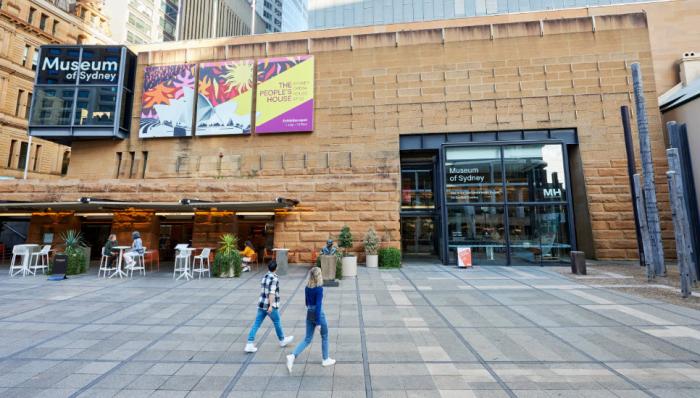Museum of Sydney | Open Hours & Tickets

Museum of Sydney is open daily 10am-5pm
Closed Good Friday and Christmas Day
A modern museum built over and around the remains of Australia's first Government House, the Museum of Sydney celebrates the people and events that have shaped the character and soul of this city.
Admission
Ticket prices: Free entry
Admission charges apply to some exhibitions
Permanent Displays
YURA NURA: PEOPLE & COUNTRY
Yura Nura: People & Country presents contemporary Aboriginal reflections on the history of Sydney and colonisation.
The relationship between the British and Aboriginal peoples largely began around Warrane (Sydney Cove) on the site where the first Government House was built and the Museum of Sydney now stands (near present-day Circular Quay). From its construction in 1788 to its demolition in 1845, the first Government House was the centre of colonial power in Australia. Imposing British law on Aboriginal people, multiple governing documents were signed within its walls that had, and continue to have, direct impact on Indigenous people across Australia.
This permanent display provides a glimpse into the complex relationship between this significant site and Aboriginal peoples and land, then and now. A film explores key events in the early years of the colony and includes personal reflections on the impacts still felt by Aboriginal people today. Three artworks by Gordon Syron, a Worimi/Biripi man from the Mid North Coast of NSW, offer a contemporary artistic Aboriginal interpretation of the arrival of the First Fleet in Sydney Cove in 1788. These works challenge the British idea of 'nobody's land' and explore the impacts of first contact and the continued colonisation of Australia.
EDGE OF THE TREES
Edge of the Trees is a site-specific piece commissioned for the forecourt of the Museum of Sydney at its opening in 1995. The installation was created by artists Fiona Foley and Janet Laurence.
Their award-winning public art installation evokes the cultural and physical history of the site, before and after 1788: a pivotal turning point in our history, when contact and invasion / colonisation took place.
The name of the sculpture comes from an essay by historian Rhys Jones, 'Ordering the Landscape' in I & T Donaldson's Seeing the First Australians, Sydney 1985:
...the 'discoverers' struggling through the surf were met on the beaches by other people looking at them from the edge of the trees. Thus the same landscape perceived by the newcomers as alien, hostile, or having no coherent form, was to the indigenous people their home, a familiar place, the inspiration of dreams.
A 'forest' of 29 massive pillars - sandstone, wood and steel - cluster near the museum entrance. Wooden pillars from trees once grown in the area have been recycled from lost industrial buildings of Sydney. The names of 29 Aboriginal clans from around Sydney correspond to the 29 vertical poles. Walking between the pillars you hear a soundscape of Koori voices reciting the names of places in the Sydney region that have today been swallowed up by the metropolis.
Organic materials such as human hair, shell, bone, feathers, ash and honey, are embedded in windows within the elements, evoking prior ways of life. Natural and cultural histories are evoked by the names of botanical species carved or burnt into wooden columns in both Latin and Aboriginal languages, along with the signatures of First Fleeters. Place names are engraved on the sandstone pillars in English and Aboriginal languages.
FIRST FLEET SHIPS
In 1788, after more than eight months at sea, the First Fleet landed, transporting some 1500 people to set up a new penal colony for Britain at the far end of the earth.
This display explores the journey, arrival and first contacts of this fleet's largely unwilling human cargo.
The First Fleet models on display at the Museum of Sydney were built by modelmakers Lynne and Laurie Hadley following nine years of painstaking research into original plans, drawings and British archival documents. Each ship is built on a 1:48 scale,from western red cedar or Syrian cedar.
SYDNEY VISIONARIES
Cities are collective enterprises, reflecting the decisions, dreams and lives of innumerable citizens, past and present.
This display recounts the stories and legacy of ten individuals who through intellect, determination and passion, had a dramatic influence on Sydney's natural and built environment.
GADIGAL PLACE
The Aboriginal people who encountered the First Fleet in 1788 belonged to a sophisticated and culturally diverse population whose ancestors had lived in this region - now called Sydney - for at least 60,000 years.
Gadigal land, where the Museum of Sydney now stands, covered the southern shore of Sydney Harbour from Watsons Bay to Sydney Cove. The coastal Eora (meaning people) were saltwater people who lived on the rich resources of the harbour and rivers. An estimated 250 different languages were once spoken across the continent; in the Sydney region alone there were at least 30 distinct clan groups, speaking several languages, including Darug and Dharawal.
Governor Phillip struggled to communicate with the diverse Aboriginal communities of Sydney. In an attempt to conciliate and understand the natives, Governor Phillip captured Arabanoo in December of 1788 before Government House had been built.
Arabanoo is a key character in the history of Aboriginal Sydney. He was held captive during the construction of the first Government House and saw the effects of the British colony on Aboriginal people. Fifteen months after the arrival of the First Fleet, Sydney's Aboriginal clans were decimated by an outbreak of smallpox, which caused terrible suffering and social upheaval. Arabanoo died as a result of the outbreak, and it is estimated that the disease also killed between 50 and 90 percent of the population.
Yet, through cultural resilience and astonishing adaptability, the Aboriginal people of Sydney have survived. They are today a dynamic part of our city with deep spiritual connections to this land.
The Gadigal Place gallery honours the diverse and complex history, culture and survival of the Gadigal clan on whose land this museum stands, and acknowledges the complexity and ongoing variety of Aboriginal communities in the Sydney region today.
Getting here
Address
Corner Phillip and Bridge Streets, Sydney, NSW 2000
By public transport
We are located one block back from Circular Quay, which is serviced by trains, buses and ferries.
For up-to-date timetables or to find the quickest public transport routes visit the Transport Infoline or call 131500.
By road
Parking
We don't have parking at the museum, and street parking is very limited. The nearest carpark is Governor Phillip & Macquarie Tower. Enter from Young Street / Farrer Place. Visitors are advised to check parking rates.
The Sofitel Sydney Wentworth Car Park offers a discounted all-day parking rate of $40 to our visitors when pre-booking parking with Book A Bay. The discount is available Monday - Friday, exit before 5pm. To receive the discounted rate, visit Book A Bay, select your car park and enter the promo code SLM. The parking station is a 5 minute walk to Museum of Sydney.
The Domain parking station, which is about 15 minutes' walk from the museum, also offers a special discount to Museum of Sydney visitors.
Buses and cars can stop on Bridge Street and Young Street to drop-off and pick-up. There are bus parking zones on Macquarie Street which require drivers to remain with their vehicles.
Cycling
We have onsite bike racks for bike parking off Phillip Street on the mezzanine above the restaurant.
❊ Official Tickets ❊
Book Online Here
❊ When ❊
Happens: Monday, Tuesday, Wednesday, Thursday, Friday, Saturday, Sunday
Times: 10AM - 5PM
❊ Where ❊
Museum of Sydney View Venue
Cnr Phillip St and Bridge St Sydney New South Wales 2000 Map
℅ Warrane
✆ Venue: 61 2 8239 2211 | Event: 61 2 8239 2211
✆ Venue: 61 2 8239 2211 | Event: 61 2 8239 2211
❊ Web Links ❊
→ Museum of Sydney | Open Hours & Tickets→ www.mhnsw.au
→ Disclaimer: Details can change at any time. Always check with the advertiser before making plans, buying tickets or proceeding .. more
Update This Page









